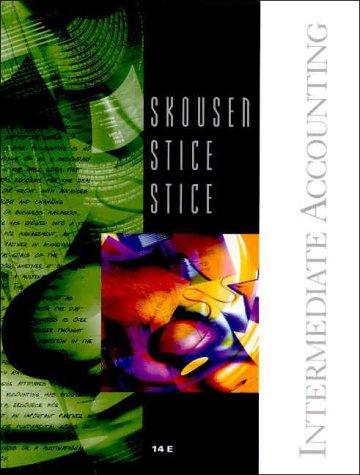Question
Question 11 (1 point) A capital asset was purchased on January 1 for $30,000 with an estimated residual value of $6,000 at the end of
Question 11 (1 point)
A capital asset was purchased on January 1 for $30,000 with an estimated residual value of $6,000 at the end of its useful life. The current year's Amortization Expense is $3,000 calculated on the straight-line. The estimated useful life of the plant asset is
Question 11 options:
|
|
| ||
|
|
| ||
|
|
| ||
|
|
|
Question 12 (1 point)
A change in the estimated useful life of equipment requires
Question 12 options:
|
| retroactive change in the amount of periodic amortization recognized in previous years. |
|
| that no change be made in the periodic amortization so that amortization amounts are comparable over the life of the asset. |
|
| that the amount of periodic amortization be changed in the current year and in future years. |
|
| that income for the current year be increased. |
Question 13 (1 point)
If a capital asset is retired before it is fully amortized, and the residual value received is less than the asset's book value,
Question 13 options:
|
|
| ||
|
|
| ||
|
|
| ||
|
|
|
Use the following information for questions 14-16.
A company purchased property for $300,000. The property included an acre of land valued at $50,000, a building valued at $150,000, and equipment valued at $125,000.
Question 14 (1 point)
The land will be recorded at a cost of
Question 14 options:
|
|
| ||
|
|
| ||
|
|
| ||
|
|
|
Use the following information for questions 14-16.
A company purchased property for $300,000. The property included an acre of land valued at $50,000, a building valued at $150,000, and equipment valued at $125,000.
Question 15 (1 point)
The building will be recorded at a cost of
Question 15 options:
|
| $150,000. |
|
| $140,000. |
|
| $135,000. |
|
| $138,461. |
Use the following information for questions 14-16.
A company purchased property for $300,000. The property included an acre of land valued at $50,000, a building valued at $150,000, and equipment valued at $125,000.
Question 16 (1 point)
The equipment will be recorded at a cost of
Question 16 options:
|
| $115,384. |
|
| $118,723. |
|
| $120,000. |
|
| $125,000. |
Question 17 (1 point)
According to the matching principle, future removal and site restoration costs, especially for a natural resource, must be
Question 17 options:
|
|
| ||
|
|
| ||
|
|
| ||
|
|
|
Question 18 (1 point)
Your business receives full payment of $500 for an account receivable that was previously written off is collected. Before the entry to record the payment is recorded, the following entry must be made
Question 18 options:
|
| Debit Accounts Receivable, Credit Allowance for Doubtful Accounts |
|
| Debit Allowance for Doubtful Accounts, Credit Accounts Receivable |
|
| Debit Bad Debts Expense, Credit Allowance for Doubtful Accounts |
|
| Debit Bad Debts Expense, Credit Accounts Receivable |
Question 19 (1 point)
Which of the following is an intangible asset that results from the purchase of a business for more than its net asset value?
Question 19 options:
|
| Goodwill |
|
| Patent |
|
| Trademark |
|
| Trade name |
Question 20 (1 point)
Research costs not related a specific product
Question 20 options:
|
| are classified as intangible assets. |
|
| must be expensed when incurred under generally accepted accounting principles. |
|
| should always be capitalized rather than expensed |
|
| are capitalized and then amortized over a period not to exceed 40 years. |
Question 21 (1 point)
The Income Statement Method of estimating bad debts:
Question 21 options:
|
|
| ||
|
|
| ||
|
|
| ||
|
|
|
Question 22 (1 point)
When using the Balance Sheet method, a percentage of the outstanding accounts receivable is calculated as the estimate of uncollectible bad debts. That calculated amount is:
Question 22 options:
|
| Added to the Allowance for Doubtful Accounts |
|
| Subtracted from the Allowance for Doubtful Accounts |
|
| The new balance of Allowance for Doubtful Accounts |
|
| Expensed completely. |
Question 23 (1 point)
When an Accounts Receivable is written off:
Question 23 options:
|
| Bad Debt Expense is credited |
|
| Allowance for Doubtful Accounts is credited |
|
| Accounts Receivable is credited |
|
| Sales is credited. |
Question 24 (1 point)
A promissory note is issued when:
Question 24 options:
|
|
| ||
|
|
| ||
|
|
| ||
|
|
|
These are ALL ONE question. Thanks
Step by Step Solution
There are 3 Steps involved in it
Step: 1

Get Instant Access to Expert-Tailored Solutions
See step-by-step solutions with expert insights and AI powered tools for academic success
Step: 2

Step: 3

Ace Your Homework with AI
Get the answers you need in no time with our AI-driven, step-by-step assistance
Get Started


